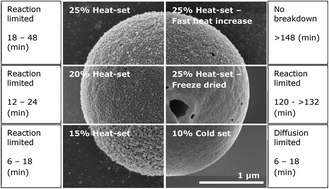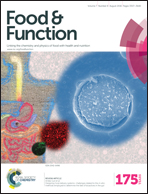Structure engineering of filled protein microbeads to tailor release of oil droplets in gastric digestion
Abstract
Oil-soluble components can be encapsulated in an O/W1/W2 microsystem, in which they are dissolved in oil droplets dispersed in a gelled microbead (W1), which forms a barrier between the oil droplets and the aqueous continuous phase (W2). We investigated the rate and mechanism of breakdown of protein microbeads in a simulated gastric system, and studied the influence of microbead protein concentration, gelling method (cold-set, slow and fast heat-set), and further processing (freeze-drying), on the breakdown process. Breakdown rate decreased with increasing protein content of the beads, for the same method of production. Due to the porosity of the slowly-heated heat-set beads, breakdown occurred evenly throughout the entire bead. Cold-set microbeads of 10% protein broke down slightly slower than the heat-set microbeads of 15%. The denser surface of the 10% beads slowed down the diffusion of the enzymes into the bead's interior, causing the beads to be broken down from the outside inward. All these beads broke down within one hour. Increasing the rate of temperature increase during the heating step dramatically slowed breakdown. There was no significant breakdown of rapidly heated beads within 138 minutes, even though no difference in microstructure between rapidly and slowly heated beads was visible with electron microscopy. Freeze-drying of the beads also slowed their breakdown. After 132 minutes more than half the measured particle volume of were intact beads. Freeze-drying changed the microstructure of the beads irreversibly: rehydrating the dried beads did not result in a breakdown behaviour similar to that of unprocessed beads.


 Please wait while we load your content...
Please wait while we load your content...